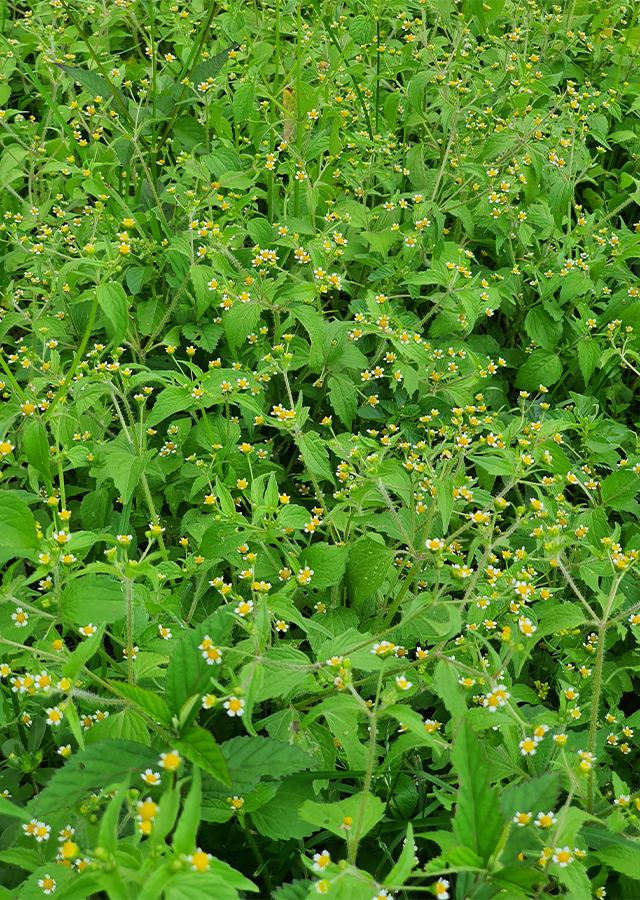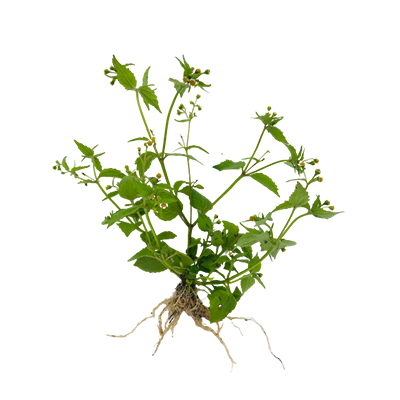Gallant Soldier
Galinsoga parviflora Cav.
Asteraceae
Location in our garden
Principal



Synonym
Adventina parviflora (Cav.) Raf.
Baziasa microglossa Steud.
Galinsoga acmella Steud.
Habitus
Herbaceous. Slender, herbaceous, annual plant, growing from 20-70 cm tal
Part Used
Leaves
Flowers
Roots
Stem
Growing Requirements
Full Sunshine
Habitat
Wetland
Riverbanks
Coastal
Grassland
Overview
Originates from South America. It has been introduced elsewhere and it can be found in both temperate and tropical regions. In tropical Africa it is widespread and has been collected in Cape Verde, Central, Eastern and Southern Africa, and the Indian Ocean islands. Now, it is a cosmopolitan weed.
Vernacular Names
Marchia (India), Niu xi ju (Chinese), Hakidamegiku (Japanese), Khanna (Pakistan), Boton de oro (Spanish), Galinsoga à petites fleurs (French), Botao-de-ouro (Portuguese), Galinsoga (Tagalog-Philippines), Bribil (Indonesia)
Agroecology
Found in arable land, waste places, pavements in towns, often in partial shade. Also in disturbed soils, fields, orchards, gardens, lawns, roadsides from sea level to 2,300 m. An easily grown plant, it succeeds in most soils preferring well-drained conditions with ample nutrients and full sun or partial shade. It requires medium to high rainfall conditions. Locally very abundant, because of its quick growth it can become a troublesome weed.
Morphology
- Stems - erect to ascending, 20–6 cm tall, glabrous or sparsely pubescent.
- Leaves - opposite, simple, petiole 2–15 mm long; blade ovate or ovate-oblong, 1–6.5 cm × 0.5–4.5 cm, margin shallowly serrate, have three transparent main nerves.
- Flowers - inflorescence a terminal or axillary head, often in pairs, involucral bracts in 2 rows- , glabrous, pales present, trifid. Rayflowers female, usually 5, white, with shortligule and marked tube; disk flowers tubular, yellow.
- Fruits - achene 1–2 mm long, central achenes ovate, black, with pappus consisting of white, fimbriate scales as long as the fruit, marginal achenes without pappus.
Cultivation
By seeds - sow in situ. Germination can take place at temperatures between 10-35 °C; it usually takes place within a month. Light, as well as alternating temperatures, may favour germination.
Chemical Constituents
Flavonoids (patulitrin, quercimeritrin, quercitagetrin), diterpenoids, caffeic acid, steroids, phenolic, saponins, polyphenol, cafffeoyl, aromatic ester.
Traditional Medicinal Uses
Medicinal Uses
- Considered astringent, anti-inflammatory and vulnerary.
- Studies have shown wound healing, antioxidant, antihypertensive, and ACE-inhibitory (Angiotensin-converting enzyme inhibitors-a group of medicine that are mainly used to treat certain heart and kidney conditions).
- It exhibited significant antifungal activities against A. niger and C. albicans.
Traditional Uses
- When rubbed onto the body, the plant is useful in treating nettle stings
- The juice of the plant is applied to treat wounds, it helps to coagulate the blood of fresh cuts and wounds.
- In Columbia, decoction of leaves used for excess stomach acids.
- In China, whole plant used as hemostatic and anti-inflammatory.
- In Manipur, India, salted extract of leaves given for diarrhea, fever, and vomiting; also, for boils and small pox.
Part Used
Reference Sources
- Ali, S., Zameer, S., & Yaqoob, M. (2017). Ethnobotanical, phytochemical and pharmacological properties of Galinsoga parviflora (Asteraceae): A review. Tropical Journal of Pharmaceutical Research Vol. 16 (12): 3023-3033. https://www.tjpr.org/admin/12389900798187/2017_16_12_29.pdf. 30-01-2021.
- CABI. (2014). Invasive Species Compendium. Galinsoga parviflora(gallant soldier). https://www.cabi.org/isc/datasheet/25299 30-01-2021
- Fern, Ken (2014). Useful Tropical Plants. Galinsoga parviflora. http://tropical.theferns.info/viewtropical.php?id=Galinsoga+parviflora 30-01-2021
- Pl@nt Use. (2004). Galinsoga parviflora (PROTA). https://uses.plantnet-project.org/en/Galinsoga_parviflora_(PROTA) 30-01-2021
- StuartXchange. (2016). Philippine Medicinal Plants. Gallant soldier. http://www.stuartxchange.org/GallantSoldier. 30-01-2021
- Siemonsma, J.S. & K. Piluek (eds.). (1994). Plant Resources of South-East Asia No. 8 Vegetables. PROSEA Foundation, Bogor.

